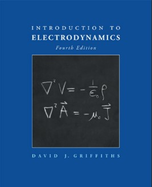Solution Found!
[The naive explanation for the pressure of light offered
Chapter 9, Problem 34P(choose chapter or problem)
Problem 34P
[The naive explanation for the pressure of light offered in Section 9.2.3 has its flaws, as you discovered if you worked Problem 9.11. Here’s another account, due originally to Planck.25] A plane wave traveling through vacuum in the z direction encounters a perfect conductor occupying the region z ≥ 0, and reflects back:
(a) Find the accompanying magnetic field (in the region z < 0).
(b) Assuming B = 0 inside the conductor, find the current K on the surface z = 0, by invoking the appropriate boundary condition.
(c) Find the magnetic force per unit area on the surface, and compare its time average with the expected radiation pressure (Eq. 9.64).
Reference prob 9.11
Consider a particle of charge q and mass m, free to move in the xy plane in response to an electromagnetic wave propagating in the z direction (Eq. 9.48—might as well set δ = 0).
(a) Ignoring the magnetic force, find the velocity of the particle, as a function of time. (Assume the average velocity is zero.)
(b) Now calculate the resulting magnetic force on the particle.
(c) Show that the (time) average magnetic force is zero.
The problem with this naive model for the pressure of light is that the velocity is 90 ? out of phase with the fields. For energy to be absorbed, there’s got to be some resistance to the motion of the charges. Suppose we include a force of the form −γmv, for some damping constant γ .
(d) Repeat part (a) (ignore the exponentially damped transient). Repeat part (b), and find the average magnetic force on the particle.9
Questions & Answers
QUESTION:
Problem 34P
[The naive explanation for the pressure of light offered in Section 9.2.3 has its flaws, as you discovered if you worked Problem 9.11. Here’s another account, due originally to Planck.25] A plane wave traveling through vacuum in the z direction encounters a perfect conductor occupying the region z ≥ 0, and reflects back:
(a) Find the accompanying magnetic field (in the region z < 0).
(b) Assuming B = 0 inside the conductor, find the current K on the surface z = 0, by invoking the appropriate boundary condition.
(c) Find the magnetic force per unit area on the surface, and compare its time average with the expected radiation pressure (Eq. 9.64).
Reference prob 9.11
Consider a particle of charge q and mass m, free to move in the xy plane in response to an electromagnetic wave propagating in the z direction (Eq. 9.48—might as well set δ = 0).
(a) Ignoring the magnetic force, find the velocity of the particle, as a function of time. (Assume the average velocity is zero.)
(b) Now calculate the resulting magnetic force on the particle.
(c) Show that the (time) average magnetic force is zero.
The problem with this naive model for the pressure of light is that the velocity is 90 ? out of phase with the fields. For energy to be absorbed, there’s got to be some resistance to the motion of the charges. Suppose we include a force of the form −γmv, for some damping constant γ .
(d) Repeat part (a) (ignore the exponentially damped transient). Repeat part (b), and find the average magnetic force on the particle.9
ANSWER:
Step 1 of 3
Part a
We are required to calculate the magnetic field corresponding to the given electric field
Both fields are mutually perpendicular. Therefore, the corresponding magnetic field will be
